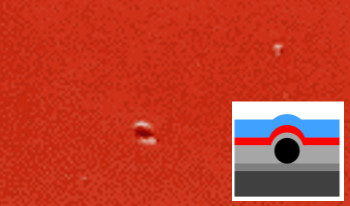References
1
2LouH. H.HuangY. L.2003Hierarchical decision making for proactive quality control: system development for defect reduction in automotive coating operationsEng. Appl. Artif. Intell.16237250237–5010.1016/S0952-1976(03)00060-5
3TanakaK.ShinbaraY.IkedaH.YamadaN.KibaH.SasanishiK.1994Automated inspection method for painted surfacesTrans. Jap. Soc. Mech. Eng.60866873866–73
4
5NikolenkoS. I.Synthetic Data for Deep Learning.2021SpringerCham174
6RajpuraP. S.HegdeR. S.BojinovH.
7KazuhisaT2009Biofouling in seawater reverse osmosis desalination plantBull. Soc. Sea Water Sci., Jpn.63303306303–6
8O’ByrneM.PakrashiV.SchoefsF.GhoshB.2018Semantic segmentation of underwater imagery using deep networks trained on synthetic imageryJ. Marine Sci. Eng.69310.3390/jmse6030093
9QueirozR.CohenM.MoreiraJ. L.BraunA.Jacques JuniorJ. C.MusseS. R.2010Generating facial ground truth with synthetic faces2010 23rd SIBGRAPI Conf. on Graphics253125–31IEEEPiscataway, NJ10.1109/SIBGRAPI.2010.12
10DongY.LinM.YueJ.ShiL.2019A low-cost photorealistic CG dataset rendering pipeline for facial landmark localizationMultimedia Tools Appl.78223972242022397–42010.1007/s11042-019-7516-5
11RaghebH.VelastinS.RemagninoP.EllisT.2008Vihasi: virtual human action silhouette data for the performance evaluation of silhouette-based action recognition methods2008 2nd ACM/IEEE Int’l. Conf. on Distributed Smart Cameras1101–10IEEEPiscataway, NJ10.1109/ICDSC.2008.4635730
12De SouzaC. R.GaidonA.CabonY.L’opezA. M.2017Procedural generation of videos to train deep action recognition networks2017 IEEE Conf. on Computer Vision and Pattern Recognition (CVPR)259426042594–604IEEEPiscataway, NJ10.1109/CVPR.2017.278
13VarolG.RomeroJ.MartinX.MahmoodN.BlackM. J.LaptevI.SchmidC.2017Learning from synthetic humans2017 IEEE Conf. on Computer Vision and Pattern Recognition (CVPR)462746354627–35IEEEPiscataway, NJ10.1109/CVPR.2017.492
14JiS.XuW.YangM.YuK.20133D Convolutional neural networks for human action recognitionIEEE Trans. Pattern Anal. Mach. Intell.35221231221–3110.1109/TPAMI.2012.59
15CollinsT.MaktabiM.BarberioM.BencteuxV.Jansen-WinkelnB.ChalopinC.MarescauxJ.HostettlerA.DianaM.GockelI.2021Automatic recognition of colon and esophagogastric cancer with machine learning and hyperspectral imagingDiagnostics11181010.3390/diagnostics11101810
16BallasN.YaoL.PalC.CourvilleA.2016Delving deeper into convolutional networks for learning video representationsInt’l. Conf. on Learning Representations (ICLR)1111–1110.48550/arXiv.1511.06432
17WangX.XieW.SongJ.2018Learning spatiotemporal features with 3DCNN and ConvGRU for video anomaly detection2018 14th IEEE Int’l. Conf. on Signal Processing (ICSP)474479474–9IEEEPiscataway, NJ10.1109/ICSP.2018.8652354
18LiuY.ZhangT.LiZ.20193DCNN-based real-time driver fatigue behavior detection in urban rail transitIEEE Access7144648144662144648–6210.1109/ACCESS.2019.2945136
19HsiehY. Z.JengY. L.2018Development of home intelligent fall detection IoT system based on feedback optical flow convolutional neural networkIEEE Access6604860576048–5710.1109/ACCESS.2017.2771389
20LinC. H.TsaiM. Y.ChouP. Y.2021A lightweight fine-grained action recognition network for basketball foul detection2021 IEEE Int’l. Conf. on Consumer Electronics-Taiwan (ICCE-TW)121–2IEEEPiscataway, NJ10.1109/ICCE-TW52618.2021.9602903
21ZhangD.LiC.LinF.ZengD.GeS.2021Detecting deepfake videos with temporal dropout 3DCNNProc. 13th Int’l. Joint Conf. on Artificial Intelligence (IJCAI-21)128812941288–94IEEEPiscataway, NJ10.24963/ijcai.2021/178
22WangY.DantchevaA.2020A video is worth more than 1000 lies. Comparing 3DCNN approaches for detecting deepfakes2020 15th IEEE Int’l. Conf. on Automatic Face and Gesture Recognition (FG 2020)515519515–9IEEEPiscataway, NJ10.1109/FG47880.2020.00089
23
24YoshidaR.NagaiY.KashiwabaraM.
25
26Dunford.R.SuQ.TamangE.2014The pareto principlePlymouth Stud. Sci.7140148140–8
27JainG.MittalD.TakurD.MittalM. K.2020A deep learning approach to detect COVID-19 coronavirus with X-ray imagesBiocybern. Biomed. Eng.40139114051391–40510.1016/j.bbe.2020.08.008
28Abdelaziz IsmaelS.MohammedA.HefnyH.2020An enhanced deep learning approach for brain cancer MRI images classification using residual networksArtif. Intell. Med.10210177910.1016/j.artmed.2019.101779
29BradleyA. P.1997The use of the area under the ROC curve in the evaluation of machine learning algorithmsPattern Recognit.30114511591145–5910.1016/S0031-3203(96)00142-2
30HandD. J.TillR. J.2001A simple generalisation of the area under the roc curve for multiple class classification problemsMach. Learn.45171186171–8610.1023/A:1010920819831
31HanleyJ. A.1989Receiver operating characteristic (ROC) methodology: the state of the artCrit. Rev. Diagn Imag.29307335307–35

 Find this author on Google Scholar
Find this author on Google Scholar Find this author on PubMed
Find this author on PubMed
 Open access
Open access